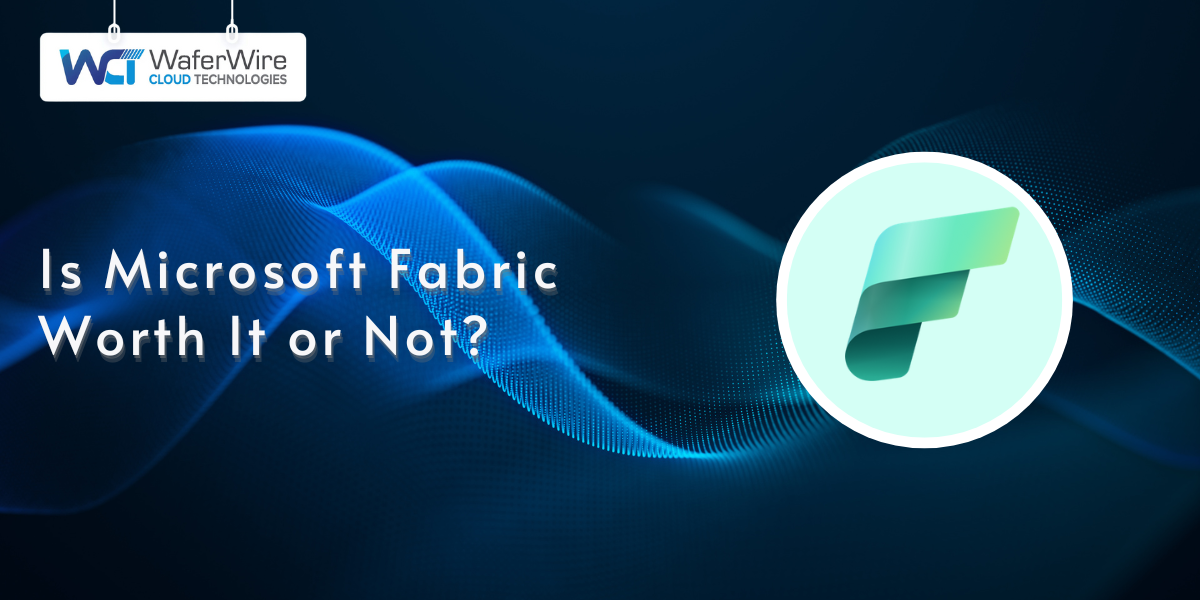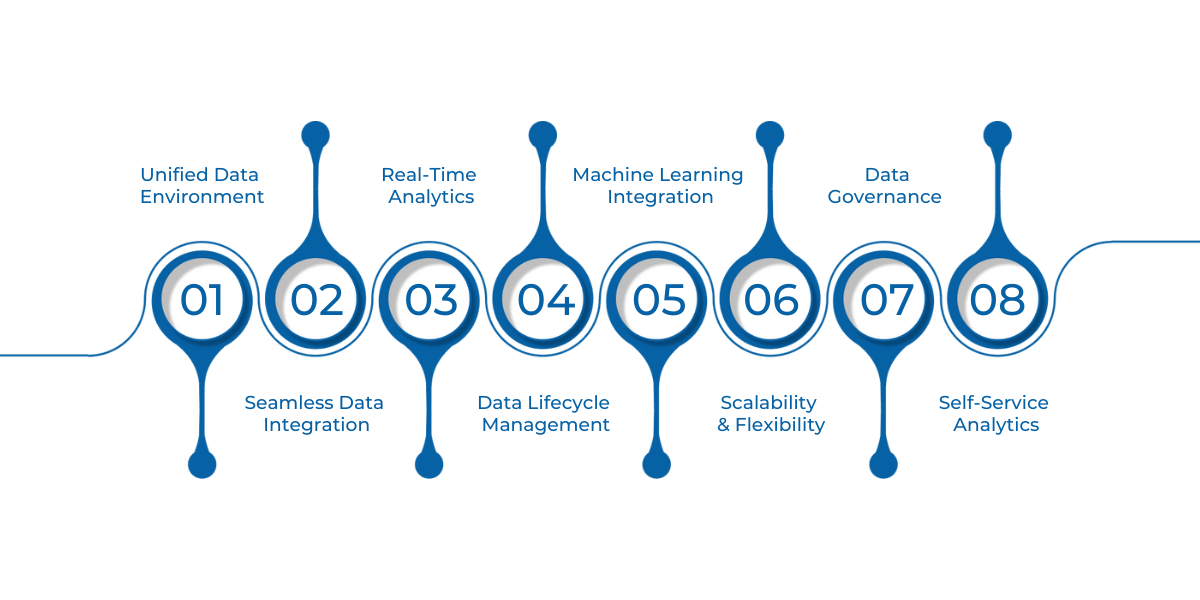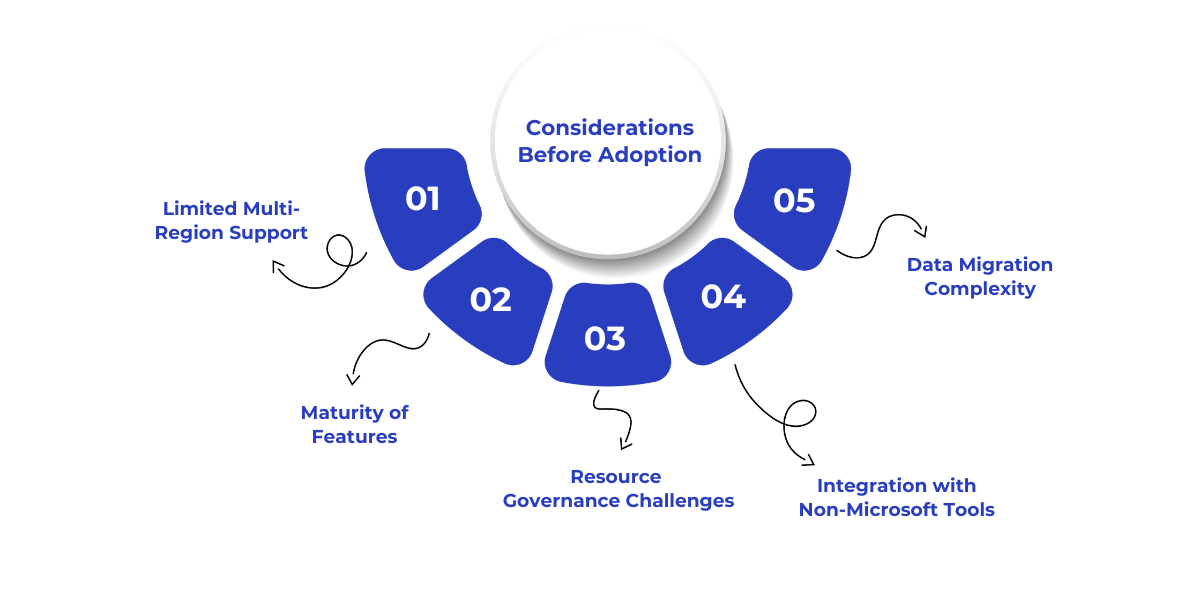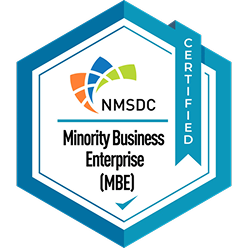

As businesses continue to rely more heavily on data, the need for powerful, unified platforms that can handle everything from analytics to machine learning is more critical than ever.
But with the rapid rise of cloud solutions, businesses are left wondering: is Microsoft Fabric truly worth it, or is it just another overhyped tech buzzword?
In this blog, we’ll dive into the capabilities, benefits, and potential drawbacks of Microsoft Fabric, providing you with the insight you need to evaluate whether it’s the right fit for your business.
Microsoft Fabric is a unified data platform that integrates all aspects of data management, analytics, and artificial intelligence under a single umbrella. Designed to streamline the end-to-end process of working with data, it brings together tools and capabilities to assist businesses in ingesting, transforming, analyzing, and deploying data-driven insights. Leveraging cloud-native services built on top of Azure, Fabric offers a scalable, secure, and flexible environment for organizations to manage their growing data needs.
Microsoft Fabric is built with the vision to simplify the complexity of modern data systems. Rather than relying on multiple disparate tools and services, businesses can now use one platform to access and manage everything from basic data processing to advanced machine learning model integration.
The platform integrates seamlessly with Power BI and other Microsoft services, making it an attractive option for enterprises that are already invested in the Microsoft ecosystem.
Suggested read: Microsoft Fabric: Top Use Cases for Data and Analytics
With a clearer understanding of what Microsoft Fabric offers, let’s explore its key features to determine how it can truly benefit your organization.

Microsoft Fabric is a versatile, next-gen platform designed to address modern data management needs. It brings together data engineering, analytics, and machine learning into a cohesive ecosystem, allowing organizations to streamline operations and make data-driven decisions faster. Below are some of the key features that set Microsoft Fabric apart from other platforms in the market:
One of the standout features of Microsoft Fabric is its unified environment. Traditionally, businesses have to use a variety of disparate tools for different aspects of data management, from data ingestion and storage to analytics and machine learning. Microsoft Fabric changes that by bringing all these functions into one platform, making it much easier for businesses to manage their data flows and operations.
This unified experience eliminates the need for managing multiple systems and platforms, which can be both time-consuming and prone to error. Teams can collaborate better, as they can work with the same data sets across departments and stages of the process, from raw data to actionable insights.
Microsoft Fabric is designed to integrate seamlessly with a variety of Microsoft and third-party tools. The platform enables businesses to integrate data from various sources, including internal databases, cloud services, and external APIs. Its integration with Azure Synapse Analytics, Power BI, and other Azure services makes it easy to centralize data, enabling teams to draw insights from a single, cohesive data repository.
With Fabric, businesses can forget about data silos and rely on the ability to pull in data from various sources into one system. It even facilitates easy data migration, giving organizations the flexibility to transfer and store data securely and efficiently.
Speed is everything in today's fast-paced business world. Microsoft Fabric enables real-time analytics, which means data can be analyzed and acted upon as soon as it's ingested. This is particularly crucial in industries like finance, healthcare, and retail, where quick decision-making can lead to a competitive edge. The platform enables users to perform analytics on live data, which is continuously updated, providing them with the most up-to-date information possible.
It doesn't matter if you're monitoring website traffic, tracking sales performance, or assessing financial transactions; Fabric’s real-time analytics ensures you have insights immediately, helping you to adapt quickly to changes or emerging trends.
Another compelling feature of Microsoft Fabric is its support for the entire data lifecycle. The platform allows you to manage everything from data ingestion and transformation to visualization and model deployment. It’s a one-stop shop for businesses that need to move from raw data to actionable insights without relying on multiple tools.
For data engineers, this means they can handle complex data transformations and preparation directly in Fabric. For data analysts, the easy-to-use interface and integration with tools like Power BI make data visualization and reporting a breeze. Even data scientists can easily integrate machine learning workflows into their data pipeline, ensuring every stage of the process is streamlined and connected.
Unlike many other platforms that require you to use separate tools for machine learning, Microsoft Fabric integrates this directly into its ecosystem. This means you can build, train, and deploy machine learning models without leaving the platform. Fabric provides a unified environment for working with data, training models, and making predictions. This integration eliminates the need for complex pipelines and accelerates the overall process.
By using Fabric for machine learning, businesses can leverage the power of AI for predictive analysis, customer insights, fraud detection, and much more. Even if you're working with supervised, unsupervised, or reinforcement learning models, Microsoft Fabric’s tools and integration capabilities give data scientists and engineers the flexibility they need.
Also read: Modernizing Legacy Systems: Complete Guide and Strategies
Microsoft Fabric is built with scalability in mind. As your data grows and your business expands, the platform can scale alongside you, providing a flexible solution for your changing needs. Whether you're working with petabytes of data or need to accommodate sudden spikes in data usage, Fabric can dynamically scale to meet those requirements.
This flexibility is particularly useful for enterprises that deal with large volumes of data from various sources. It can be anything: if you're storing historical data, running real-time analytics, or training complex machine learning models, Microsoft Fabric adapts to your data environment, allowing you to focus on business innovation rather than managing infrastructure.
Data governance and security are top priorities for businesses, especially when working with sensitive customer information or financial data. Microsoft Fabric ensures robust security features, including data encryption, access controls, and role-based permissions, to ensure that only authorized users can access certain datasets. Compliance features built into the platform help businesses adhere to regulations such as GDPR and HIPAA, ensuring that data is handled appropriately at every stage of the process.
With Fabric, businesses can track how data is used, who has accessed it, and ensure it meets all necessary compliance requirements. Whether you're dealing with internal or customer data, Fabric provides the security and audit tools to maintain full control.
In addition to serving data engineers and data scientists, Microsoft Fabric provides self-service analytics tools that empower business users to explore and analyze data on their own. By integrating seamlessly with Power BI, Microsoft Fabric allows business users to create reports, dashboards, and data visualizations without relying on IT teams.
This self-service approach makes it easier for departments across the organization to make data-driven decisions without waiting for data teams to provide the necessary insights. Users can easily access the data they need, create reports, and track performance metrics, enabling them to act quickly and effectively.
Having looked at how Microsoft Fabric and its features work, let’s now discuss whether it’s truly worth the investment for your business.

Evaluating the value of Microsoft Fabric involves considering its strengths, challenges, and how well it aligns with your organization's specific needs and existing infrastructure. Here are some considerations that you should look into before adoption:
1. Limited Multi-Region Support: Currently, Fabric's data warehousing capabilities do not support deployment across multiple geographic regions, which may be a limitation for global enterprises.
2. Maturity of Features: Some features are still evolving, and users have encountered bugs and incomplete functionalities. It's advisable to assess whether the platform's current state meets your organization's requirements.
3. Resource Governance Challenges: The absence of robust resource governance tools can lead to performance issues if workloads are not properly managed, especially in shared environments.
4. Integration with Non-Microsoft Tools: While Microsoft Fabric excels with other Microsoft products, its integration with non-Microsoft tools and third-party platforms may require extra customization and effort. This could potentially increase setup time and complexity for organizations relying heavily on other ecosystems.
5. Data Migration Complexity: Migrating data from existing systems into Microsoft Fabric can be complex, especially for large organizations with vast amounts of data. This process may require significant resources, both in terms of time and expertise, which could affect the initial cost of adoption.
In a market filled with a variety of competing platforms, it’s important to understand where Fabric stands in comparison. How does it stack up against other popular tools in terms of capabilities, ease of use, and overall value?
Let’s compare Microsoft Fabric with some of the most commonly used data management and analytics platforms, such as Databricks and Snowflake. This comparison will give you a clear picture of the advantages Fabric brings to the table, especially for enterprises and mid-market businesses looking to streamline their data workflows.
Microsoft Fabric presents a strong case for businesses looking to streamline their data management and analytics capabilities. Its unified platform and seamless integration with Microsoft’s ecosystem make it an attractive option for companies that rely on Microsoft tools. However, its worth depends on your specific needs and readiness to adopt the platform.
Microsoft Fabric has certainly positioned itself as a strong contender in the data management and analytics space. Its integration of multiple data services into a single platform simplifies many processes and enhances efficiency. However, like any tool, its value depends on your organization’s specific needs, budget, and readiness for implementation.
To determine if Microsoft Fabric is truly worth the investment, businesses need to carefully weigh the costs against the potential benefits. If you're considering adopting Microsoft Fabric or need guidance on maximizing its value, here’s how WaferWire can help:
Get in touch with WaferWire today to explore how Microsoft Fabric can transform your business’s data strategy and streamline your operations. Let us help you unlock the true potential of your data.
1. How does Microsoft Fabric integrate with third-party applications?
Microsoft Fabric primarily integrates with Microsoft tools like Power BI and Azure services, but it can also work with third-party applications through APIs and custom connectors, though additional setup may be needed.
2. What types of businesses benefit the most from Microsoft Fabric?
Enterprises and mid-market companies in industries like finance, retail, manufacturing, and utilities benefit the most due to the platform’s scalability, real-time analytics, and seamless integration with Microsoft tools.
3. Can Microsoft Fabric handle large volumes of unstructured data?
Yes, Microsoft Fabric is capable of managing large volumes of both structured and unstructured data. Its integration with Azure Synapse and other Azure services makes it adaptable to diverse data processing needs.
4. How does Microsoft Fabric ensure data compliance?
Microsoft Fabric provides built-in compliance features like data encryption, role-based access control (RBAC), and audit logging, which help businesses adhere to regulatory standards such as GDPR and HIPAA.
5. What is the cost structure of Microsoft Fabric?
The cost of Microsoft Fabric depends on factors such as data storage, usage, and service integrations. Pricing is typically subscription-based, and businesses need to assess their specific needs for a precise cost estimate.

